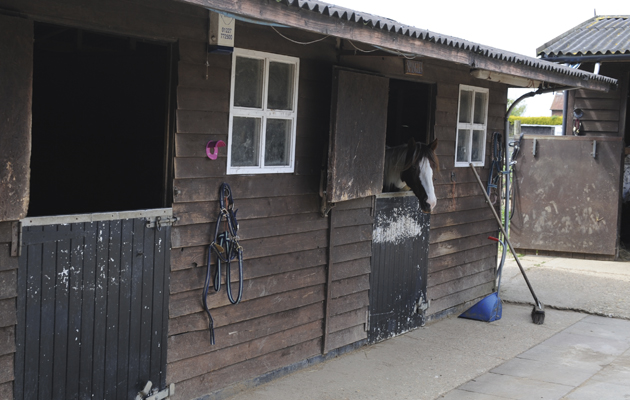The Equestrian Employers Association (EEA) is urging yards to look at their business models ahead of a hike in the minimum wage.
The national living wage, the minimum legal hourly pay for workers aged 25 and over, and national minimum wages for all younger age brackets will increase on 1 April.
The living wage will rise by 6.2%, from £8.21 to £8.72 per hour — which the government says is the “biggest cash increase ever” — with increases of between 4.6% and 6.5% for younger workers on the minimum wage, dependent on their age.
{"content":"PHA+4oCcSXQgaXMgYWJzb2x1dGVseSByaWdodCB0aGF0IGV2ZXJ5b25lIGlzIHBhaWQgZmFpcmx5LOKAncKgc2FpZCBFRUEgcHJlc2lkZW50IFR1bGxpcyBNYXRzb24uIOKAnEhvd2V2ZXIsIGluIHNvbWUgY2FzZXMgZXF1ZXN0cmlhbiBidXNpbmVzc2VzIGFyZSBhbHJlYWR5IHN0cnVnZ2xpbmc7wqB0aGlzIHJpc2Ugd2lsbCBiZSBhIGNoYWxsZW5nZSBmb3IgdGhlbS4gSXTigJlzIHZpdGFsIGluY3JlYXNlcyBpbiB0aGXCoGxpdmluZ8Kgd2FnZSBhcmUgbWFuYWdlYWJsZSBhbmQgZG8gbm90IHB1dCBqb2JzIGF0IHJpc2su4oCcVGhpcyBnb3Zlcm5tZW50IGhhcyBwcm9taXNlZCBhIHJlZHVjdGlvbiBpbiB0aGUgam9icyB0YXggdGhyb3VnaCBhbiBpbmNyZWFzZSBpbiB0aGUgZW1wbG95bWVudCBhbGxvd2FuY2UgW21vbmV5IG9mZiBhbiBlbXBsb3llcuKAmXMgbmF0aW9uYWwgaW5zdXJhbmNlIGJpbGxdLsKgV2l0aCBhwqBsaXZpbmfCoHdhZ2UgaW5jcmVhc2Ugb2YgdGhpcyBzaXplIG5vdyBvbiB0aGUgaG9yaXpvbiwgaXTigJlzIGNyaXRpY2FsIHRoYXQgaXQgZGVsaXZlcnMgc3dpZnRseS48L3A+CjxwPjxkaXYgY2xhc3M9ImFkLWNvbnRhaW5lciBhZC1jb250YWluZXItLW1vYmlsZSI+PGRpdiBpZD0icG9zdC1pbmxpbmUtMiIgY2xhc3M9ImlwYy1hZHZlcnQiPjwvZGl2PjwvZGl2PjxzZWN0aW9uIGlkPSJlbWJlZF9jb2RlLTMxIiBjbGFzcz0iaGlkZGVuLW1kIGhpZGRlbi1sZyBzLWNvbnRhaW5lciBzdGlja3ktYW5jaG9yIGhpZGUtd2lkZ2V0LXRpdGxlIHdpZGdldF9lbWJlZF9jb2RlIHByZW1pdW1faW5saW5lXzIiPjxzZWN0aW9uIGNsYXNzPSJzLWNvbnRhaW5lciBsaXN0aW5nLS1zaW5nbGUgbGlzdGluZy0tc2luZ2xlLXNoYXJldGhyb3VnaCBpbWFnZS1hc3BlY3QtbGFuZHNjYXBlIGRlZmF1bHQgc2hhcmV0aHJvdWdoLWFkIHNoYXJldGhyb3VnaC1hZC1oaWRkZW4iPg0KICA8ZGl2IGNsYXNzPSJzLWNvbnRhaW5lcl9faW5uZXIiPg0KICAgIDx1bD4NCiAgICAgIDxsaSBpZD0ibmF0aXZlLWNvbnRlbnQtbW9iaWxlIiBjbGFzcz0ibGlzdGluZy1pdGVtIj4NCiAgICAgIDwvbGk+DQogICAgPC91bD4NCiAgPC9kaXY+DQo8L3NlY3Rpb24+PC9zZWN0aW9uPjwvcD4KPHA+4oCcQXMgYSBzbWFsbCBlbXBsb3llciwgZXF1ZXN0cmlhbiBidXNpbmVzc2VzIG11c3QgY29uc2lkZXIgYSByaXNlIGluIHRoZWlyIHByaWNlcyBpbiByZXNwb25zZSB0byBsaXZpbmcgd2FnZSBpbmNyZWFzZSBvZiB0aGlzIG1hZ25pdHVkZS7CoFRoZXJlIG5lZWRzIHRvIGJlIGFuIGluZHVzdHJ5LXdpZGUgaW5jcmVhc2UsIHRoZSBlbXBsb3llciBjYW5ub3QgYmUgdGFza2VkIHdpdGggdGhpcyBvbiB0aGVpciBvd24u4oCdPC9wPgo8cD5BIHN0YXRlbWVudCBmcm9tIHRoZSBFRUEgc2FpZCBITVJDIGlzwqDigJxjZXJ0YWlubHkgdGFyZ2V0aW5nIHRoZSBlcXVlc3RyaWFuIGluZHVzdHJ54oCdwqB3aXRowqDigJxoZWZ0eSBmaW5lcyBiZWluZyBpc3N1ZWTigJ0gZm9yIG5vbi1jb21wbGlhbmNlLjwvcD4KPHA+4oCcVGhlIEVFQSBpcyBjb25jZXJuZWQgYWJvdXQgdGhlIGltcGFjdCBvbiBtYW55IGVxdWVzdHJpYW4gYnVzaW5lc3MsIHJlbWVtYmVyaW5nIHRoYXQgaXTigJlzIG5vdCBhIGNob2ljZSB0byBwYXkgW2F0IGxlYXN0XSB0aGXCoG1pbmltdW3CoHdhZ2UgW2ZvciB0aGUgcmVsZXZhbnQgYWdlXSwgaXTigJlzIHRoZSBsYXcs4oCdwqBzYWlkIGFuIEVFQSBzcG9rZXNtYW4uPC9wPgo8ZGl2IGNsYXNzPSJhZC1jb250YWluZXIgYWQtY29udGFpbmVyLS1tb2JpbGUiPjxkaXYgaWQ9InBvc3QtaW5saW5lLTMiIGNsYXNzPSJpcGMtYWR2ZXJ0Ij48L2Rpdj48L2Rpdj4KPHA+4oCcRm9yIGEgZ3Jvb20gd29ya2luZyBhIDUwLWhvdXIgd2VlaywgdGhpcyB3aWxswqBiZSBhbiBhbm51YWwgcGF5IHJpc2Ugb2YgwqMxLDMyNi7igJ08L3A+CjxwPlRoZSBFRUEgaGFzIGFsc28gcXVlc3Rpb25lZCB3aGV0aGVyIHRoZSBDb25zZXJ2YXRpdmUgUGFydHnigJlzIHBsZWRnZSB0byByYWlzZSB0aGXCoGxpdmluZ8Kgd2FnZSB0byDCozEwLjUwIGFuIGhvdXIgZm9yIGV2ZXJ5b25lIG92ZXIgMjEgYnkgMjAyNCBpcyBzdXN0YWluYWJsZSBmb3IgYW4gZXF1ZXN0cmlhbiBidXNpbmVzcy4gVGhlIEVFQSBoYXMgd29ya2VkIG91dCB0aGF0IGEgeWFyZCBlbXBsb3lpbmcgZm91ciBzdGFmZiDigJQgYWNyb3NzIGZvdXIgb2bCoHRoZSBmaXZlIG1pbmltdW0gYW5kIGxpdmluZ8Kgd2FnZSBhZ2UgYnJhY2tldHMg4oCUIG9uIGEgNTAtaG91ciB3ZWVrLCBjb3VsZCByZXN1bHQgaW4gYW4gaW5jcmVhc2UgaW4gc3RhZmZpbmcgY29zdHMgb2YgYXJvdW5kIMKjNCw1MDAgcGVyIHllYXIuPC9wPgo8ZGl2IGNsYXNzPSJhZC1jb250YWluZXIgYWQtY29udGFpbmVyLS1tb2JpbGUiPjxkaXYgaWQ9InBvc3QtaW5saW5lLTQiIGNsYXNzPSJpcGMtYWR2ZXJ0Ij48L2Rpdj48L2Rpdj4KPHA+T24gdGhlIG90aGVyIHNpZGUsIHByb3ZpZGVkIHRoZSByaXNlIGRvZXMgbm90IHJlc3VsdCBpbiBqb2Igb3IgaG91ciBjdXRzLCBlbXBsb3llZXMgb24gdGhlIGxpdmluZyB3YWdlIHdvcmtpbmcgYSAzNS1ob3VyIHdlZWsgd2lsbCBiZSBiZXR0ZXIgb2ZmIHRvIHRoZSB0dW5lIG9mIGFyb3VuZCDCozkzMCBhIHllYXIgdW5kZXIgdGhlIHByb3Bvc2FsLjwvcD4KPHA+SHViYmFyZHMgSGFsbCBMaXZlcnnigJlzIE1pa2UgSGFsbG93cywgd2hvIHdpbGwgYmUgc3BlYWtpbmcgYXQgdGhlwqBmaXJzdMKgRUVBIGNvbmZlcmVuY2XCoGluIFNocm9wc2hpcmXCoG9uIDI1IEZlYnJ1YXJ5LCB0b2xkIDxlbT5IJmFtcDtIPC9lbT4gdGhvc2Ugd2hvIHBheSBmb3Igc2VydmljZXMsIHN1Y2ggYXMgbGl2ZXJ5LCBuZWVkIHRvIHJlYWxpc2UgdGhlIGZpbmFuY2lhbCBpbXBhY3QgYW5kIHdoeSBjb3N0cyBtYXkgcmlzZS48L3A+CjxkaXYgY2xhc3M9ImFkLWNvbnRhaW5lciBhZC1jb250YWluZXItLW1vYmlsZSI+PGRpdiBpZD0icG9zdC1pbmxpbmUtNSIgY2xhc3M9ImlwYy1hZHZlcnQiPjwvZGl2PjwvZGl2Pgo8cD7igJxJdCBpc27igJl0IGJlY2F1c2UgdGhlIFtidXNpbmVzc10gb3duZXJzIG9yIHRoZSBidXNpbmVzcyBhcmUgZ2V0dGluZyBtb3JlIG91dCBvZiBpdCwgaXQgaXMgY292ZXJpbmcgb3VyIGNvc3RzIGFuZCBwZW9wbGUgaGF2ZSB0byByZWFsaXNlIHRoYXQgdGhleSBuZWVkIHRvIGJlIHByZXBhcmVkIHRvIHBheSBlbm91Z2ggZm9yIGxpdmVyeSBzbyB0aGF0IHdlIGNhbiBwYXkgdG8gcHJvdmlkZSBpdCzigJ3CoGhlIHNhaWQuPC9wPgo8cD5IZSBhZGRlZCB0aGUgaW1wYWN0IGZvciBpbmRpdmlkdWFscyB3aWxsIGFsbCBkZXBlbmQgb24gZWFjaCBwZXJzb27igJlzIGJ1c2luZXNzIG1vZGVscyBhbmQgd2hlcmUgbW9uZXkgY29tZXMgZnJvbSB0byBiYW5rcm9sbCB0aGF0LiBGb3IgZXhhbXBsZSwgaWYgYW4gZXF1ZXN0cmlhbiBidXNpbmVzcyBpcyBlbnRpcmVseSBzZWxmLXN1ZmZpY2llbnQg4oCUIHJlbHlpbmcgdG90YWxseSBvbiBtb25leSBjb21pbmcgaW4gZnJvbSB0aGUgc2VydmljZXMgaXQgcHJvdmlkZXMg4oCUIHRoZSBpbmNyZWFzZSBtYXkgaGF2ZSBhIGRpZmZlcmVudCBlZmZlY3QgdG8gYSBidXNpbmVzcyB0aGF0IGhhcyBhIHN1YnN0YW50aWFsIGFtb3VudCBvZiBjYXBpdGFsIGludmVzdGVkIGZyb20gYW5vdGhlciBzb3VyY2UuPC9wPgo8aDM+QXBwZW50aWNlc2hpcHM8L2gzPgo8cD5BbiBpbmRlcGVuZGVudCB0aGluay10YW5rIHJlcG9ydCBoYXMgcmFpc2VkIGNvbmNlcm5zIG92ZXIgdGhlIHJhcGlkIGVtZXJnZW5jZSBvZsKg4oCcZmFrZSBhcHByZW50aWNlc2hpcHPigJ0gZGlsdXRpbmcgdGhlIGFwcHJlbnRpY2VzaGlwIGJyYW5kIGFzIGEgd2hvbGUsIGJ1dCB0aGUgZXF1aW5lIHdvcmxkIGhhcyBiZWVuIHJlYXNzdXJlZCB0aGlzIGlzIG5vdCB0aGUgY2FzZSBpbiB0aGUgZXF1ZXN0cmlhbiBpbmR1c3RyeS48L3A+CjxwPkNocmlzIEhld2xldHQsIG1hbmFnaW5nIGRpcmVjdG9yIG9mIGFwcHJlbnRpY2VzaGlwIHRyYWluaW5nIHByb3ZpZGVyIEhhZGRvbiBUcmFpbmluZyBhbmQgY2hhaXJtYW4gb2YgdGhlIEJyaXRpc2ggR3Jvb21zIEFzc29jaWF0aW9uLCB0b2xkIDxlbT5IJmFtcDtIPC9lbT4gdGhlIHJlcG9ydOKAmXMgZmluZGluZyDigJxnZW5lcmFsbHkgZG9lc27igJl0IGFwcGx5IHRvIHRoZSBlcXVpbmUgaW5kdXN0cnnigJ0sIGJ1dMKgaXNzdWVzwqBhcmUgZm91bmTCoG1vcmUgd2l0aGluIHRoZSBidXNpbmVzcyBzZWN0b3IgYW5kIGFyZSBiZWluZyDigJxzdGFtcGVkIG91dOKAnS48L3A+CjxwPkhlIGFkZGVkIGFwcHJlbnRpY2VzaGlwcyBhbmQgdGhlIHdheSB0aGV5IGFyZSBydW4gaGF2ZSBiZWNvbWUgbXVjaCBtb3JlIHRyYW5zcGFyZW50LCB3aXRoIHBlcnNvbmFsIGxlYXJuaW5nIHJlY29yZHMgYW5kIGZpbmFsIGFzc2Vzc21lbnRzLjwvcD4KPHA+4oCcVGhlcmUgYXJlIHNvbWUgY2hhbGxlbmdlcyB3aXRoaW4gdGhlIFtlcXVpbmVdIGluZHVzdHJ5LOKAnSBoZSBzYWlkLiDigJxGb3IgZXhhbXBsZSwgaWYgc29tZW9uZSBkb2VzIHRoZWlyIEJIUyBzdGFnZSB0d28sIHRoZXkgY2Fubm90IHRoZW4gY29tZSBhbmQgZG8gYW4gYXBwcmVudGljZXNoaXAgbGV2ZWwgdHdvIFtvbiBhIHNpbWlsYXIgc3ViamVjdF0u4oCdPC9wPgo8cD5IZSBhZGRlZCB0aGlzLCBjb21iaW5lZCB3aXRoIGEgbGFjayBvZiBjYXJlZXJzIGFkdmljZSBpbiBzY2hvb2xzLCBjYW4gbGVhZCB0byBpbm5vY2VudCBtaXN0YWtlcyBhbmQgcGVvcGxlIGhhdmluZyB0byBiZSB0dXJuZWQgYXdheSBmcm9tIHBvc3NpYmxlIHBvc2l0aW9ucy48L3A+CjxwPkFuIG92ZXJoYXVsIG9mIGFwcHJlbnRpY2VzaGlwcyBoYXBwZW5lZCBpbiAyMDE3LCB3aXRoIHRoZSBjaGFuZ2VzIGluIHRoZSBlcXVpbmUgc2VjdG9yIGNvbWluZyBpbnRvIGZvcmNlIGFyb3VuZCAxNiBtb250aHMgYWdvLiBUaGlzIG1lYW5zIHRoZSBmaXJzdCBjb2hvcnQgdW5kZXIgdGhlIG5ldyBzY2hlbWUgaGF2ZSBvbmx5IHJlY2VudGx5IGZpbmlzaGVkIHRoZWlyIDEyLW1vbnRoIHBvc2l0aW9ucywgYW5kIGZlZWRiYWNrIHNvIGZhciBoYXMgYmVlbiBwb3NpdGl2ZS48L3A+CjxwPuKAnEl0IGlzIGEgbXVjaCBtb3JlIHN0cmluZ2VudCBwcm9kdWN0LOKAncKgc2FpZCBNciBIZXdsZXR0LCBhZGRpbmcgdGhlcmUgd2VyZSB0ZWV0aGluZyBwcm9ibGVtcywgYnV0IGl0IGlzIHdvcmtpbmcgd2VsbC7CoOKAnFBlb3BsZSBoYXZlIGVuam95ZWQgdGhlIGV4cGVyaWVuY2XCoGFuZCBlbXBsb3llcnMgdGhpbmsgaXQgaXMgbW9yZSBmaXQgZm9yIHB1cnBvc2UuPC9wPgo8ZGl2IGNsYXNzPSJpbmplY3Rpb24iPjwvZGl2Pgo8cD7igJxUaGUgbWluaW11bSB3YWdlIGluY3JlYXNlIGlzIGEgY2hhbGxlbmdlIGZvciB0aGUgZXF1aW5lIGluZHVzdHJ5LCBhbmQgd2lsbCBwdXQgcHJlc3N1cmUgcG9pbnRzIG9uIGJ1c2luZXNzZXMgdG8gc3Vydml2ZSBhbmQgdHJhaW5pbmcgcHJvdmlkZXJzIHRvIG1ha2Ugc3VyZSB0aGF0IHBlb3BsZSBhcmUgZ2VudWluZWx5IFtlbXBsb3llZCBpbiBhcHByZW50aWNlc2hpcCBwb3NpdGlvbnNdLjwvcD4KPHA+4oCcQXBwcmVudGljZXNoaXBzIGFyZSBhIGZhbnRhc3RpYyB0b29sIGluIGRldmVsb3BpbmcgdGhlIG5leHQgZ2VuZXJhdGlvbiBvZiBzdGFmZiDigJQgdGhlcmUgaXMgbm8gYmV0dGVyIHdheSB0byBkZXZlbG9wIHRob3NlIHNraWxscyB0aGFuIG9uIHRoZSBqb2IuPC9wPgo8cD7igJxUaGUgYmFja2JvbmUgb2YgdGhlIGluZHVzdHJ5IGlzIHRoZSB3b3JrIGZvcmNlLiBGb3IgYWxsIHRoZSBtZWRhbHMsIGJlaGluZCBhbGwgb2YgdGhhdCwgdGhlcmUgaXMgYSByZWFsbHkgaGFyZCB3b3JraW5nIHRlYW0u4oCdPC9wPgo8cD4K"}
You may also be interested in…
Library image.
Credit: Alamy Stock Photo
Credit: Steve Bardens
The yard owner hopes the VOA’s concessions may benefit others who could also secure discounts, but believes appealing can also
Credit: Lucy Merrell
The owner has warned other yards may be forced to close due to the tax rise, damaging the future of
The equine groom and senior equine groom apprenticeships’ standards were approved this summer
Representatives of the equine industry have two weeks to have their say in an online questionnaire about equine apprenticeships and
Stay in touch with all the news in the run-up to and throughout the major shows and events during 2025 and beyond with a Horse & Hound subscription. Subscribe today for all you need to know ahead of these major events, plus online reports on the action as it happens from our expert team of reporters and in-depth analysis in our special commemorative magazines. Have a subscription already? Set up your unlimited website access now
H&H senior news writer
Lucy is an experienced news journalist, reporter and presenter. Since joining the Horse & Hound team in 2015, Lucy has reported from major global sporting events including the Tokyo Paralympic Games and multiple European Championships, as well as Badminton, Burghley and London, to name a few. She has covered current affairs and sports news across the full spectrum of equestrian disciplines and racing, as well as human and equine welfare, industry news and court cases.






